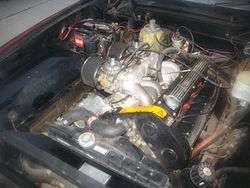Lotus 907
The Lotus 907 is an engine designed and manufactured for automotive applications by Lotus Cars. It is an all-alloy inline-4 engine with dual overhead camshafts (DOHC) and 16 valves. It displaced 1973 cc and developed approximately 144 bhp (107 kW) with dual side-draft Dell'Orto carburetors in most markets and Zenith Stromberg carburetors for US cars. It was nicknamed "The Torqueless Wonder" for its lack of bottom end but good high end horsepower.


History
The Lotus 907 was the first production variant of the Lotus 900 series engine. The Jensen-Healey was the first production car to receive the 907.
It is said that when Vauxhall unveiled its new slant-four engine at the 1967 Earls Court Motor Show its bore centers were exactly the same as those proposed by Lotus.[1]:38 Colin Chapman immediately negotiated a deal with Vauxhall to buy some of their cast-iron blocks so that development of Lotus' own aluminum cylinder head could be sped up to produce the 907 engine.
Lotus usage
The Type 75 Lotus Elite, Type 76 Lotus Eclat, and Type 79 Series 1 and early Series 2 Lotus Esprit were fitted with the 907 engine.
Problems
Oil leakage was commonplace in the first few years of production. The problem was eventually addressed by aftermarket cam cover gaskets made from reusable rubber.[2] Later 900 series Lotus engines included a revised cam tower design that greatly improved cam cover sealing. The later cam towers can be retrofitted to earlier 907 engines. Early Jensen-Healey engines (1972–1973) had oil supply issues that made the oil pressure slow to build on start-up.[3] Some early engines also had issues with oil drainage which resulted in too much oil being retained in the cam carriers.[4] Differences between 907 engines included rope seals for the rear of the crankshaft on early versions versus regular spring-loaded rubber lip seals for the rear of the crankshaft on later 907 engines.
References
- Adcock, Ian (1 April 1995). Lotus Heritage. Motorbooks International. ISBN 978-1-85532-508-1.
- Cam cover gaskets; Kemp High Performance Ltd- Retrieved 2013-12-20
- McNell, Lloyd (2000). "Cutting WEDGE". Classic Car. Retrieved 20 October 2018.
- Lotusespritworld.com; 907 oil problems- Retrieved 2013-12-20